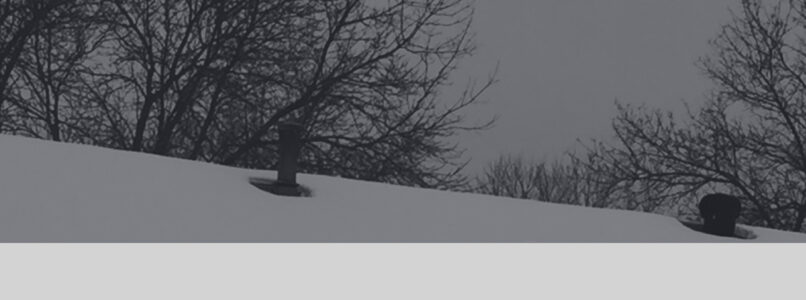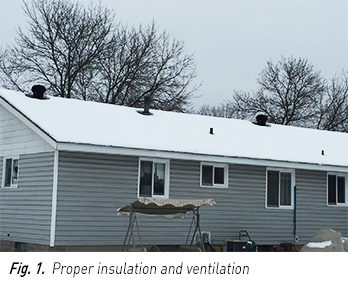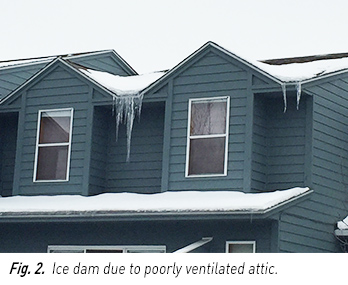How to Mitigate and Remove Ice Dams on Roofs
by Richard F. Herzog P.E., Meteorologist, RRC, Haag Principal Engineer (posted 02/2016)
During the winter in much of the US, many of our roof problems and inspections revolve around ice dams. Severe ice dams can result in water intrusion, and falling ice from roofs and eaves can cause injury and property damage to buildings and vehicles. With the large snowstorm that affected in Mid-Atlantic and Northeast in late January 2016, ice dams are sure to develop to some buildings after freeze/thaw cycling. We want to help you prepare for these types of inspections by discussing the causes of ice dams, prevention of their formation, and snow/ice removal from roofs.
Causes and Prevention
The mechanism for formation of ice dams at roof eaves is well-understood, as are the proper construction techniques to minimize this condition. According to the Asphalt Roofing Manufacturers Association (ARMA), “Ice dams are typically formed by the continual thawing and freezing of melting snow or the backing up of frozen slush in gutters. When they occur, water can be forced under the roof and may cause damage to a home’s ceilings, walls, and insulation.”1 Note that the use of self-adhering membrane (commonly referred to as “ice and water shield”) at the eaves and valleys of a roof will not prevent an ice dam from forming, but will reduce the likelihood or severity of leakage because these membranes are more water-resistant at seams and fastener penetrations than standard underlayment.
Proper ventilation and insulation of the attic space is the best prevention technique to mitigate the formation of ice dams. The 2015 International Residential Code (IRC) in section R806.2 prescribes a minimum ratio of 1:150 of net free ventilation area to attic floor area for an unconditioned attic, and this figure has remained constant for many code cycles. An exception can reduce the ventilation amount to 1:300 in Climate Zones 6, 7, or 8 if two conditions are met: a vapor barrier on the warm side of the insulation (typically the top of the ceiling) and balanced ventilation between the eave region and the ridge region.2 (Please check the local building codes for the requirements in your area.) With certain weather conditions; however, some ice damming may occur even with code-compliant construction.
The difference that attic insulation and ventilation makes can be seen in the accompanying photographs that were taken at the same time in the same area. The house on the left (Figure 1) had proper insulation and ventilation, resulting in uniform coverage of snow across the roof and no ice damming. The townhouse on the right (Figure 2) had a poorly ventilated attic, causing the upper portion of the attic to warm and melt the snow near the ridge. The melted snow re-froze at the eave, causing an ice dam to form between the gables and large icicles at the eave.
Snow and Ice Removal
Once an ice dam has formed or water intrusion has been observed, the removal of the ice can be challenging and dangerous. We have performed many inspections where we have witnessed the damage done to shingles (Figure 3) and other building components from snow and ice removal. Sometimes property owners will use axes or other tools on the roof themselves, or search the web or phone book for “snow removal services” and hire that company to clear an ice dam without realizing that the primary snow removal service offered by the company is for driveways, sidewalks, and parking lots. If snow/ice removal is necessary, it would be recommended to use a licensed roofing contractor that offers “roof-specific” ice removal, as such individuals would have the proper safety equipment to access the roof and the proper tools to avoid damaging the roof. A common method for professional services is to use steam to quickly melt the ice. A steam machine does not spray large quantities of water or high-pressure water as would a “pressure-washer,” but the high temperature melts the ice. For shoveling or any mechanical removal of snow and ice, plastic tools would be preferred over metal to avoid damaging the roof covering, flashings, or siding. So, let it snow!
Richard F. Herzog P.E., Meteorologist, RRC, and Haag Principal Engineer (02/2016)
Richard Herzog’s primary areas of consulting are Roofing Systems, Building Envelope Systems, Evaluation of Wind Damage to Structures, Construction Defect Evaluations, Meteorological Investigations, Development of Hail Analysis Software, and Alternative Dispute Resolution. He serves as a primary advisor in the creation of many Haag Education seminars and products. See his profile here.



